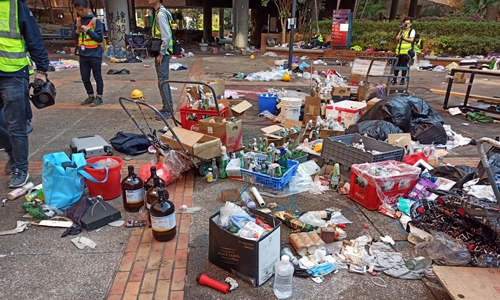HOME >> CHINA,SPECIAL-COVERAGE
Police officers, firefighters work to reopen PolyU campus
By Yin Hao and Fan Wei in Hong Kong Source:Global Times Published: 2019/11/28 11:11:17

Hong Kong police and firefighters have entered the Hong Kong Polytechnic University on November 28 to search for dangerous chemicals. Photo: Fan Wei/GT

Hong Kong police and firefighters have entered the Hong Kong Polytechnic University on November 28 to search for dangerous chemicals. Photo: Fan Wei/GT
Police, firefighters and members of the explosive ordnance disposal bureau entered Hong Kong Polytechnic University on Thursday in an operation to ensure campus safety, during which explosives including Molotov cocktails and weapons such as bows, arrows and slingshots were discovered.
At a police press conference on Thursday evening, Steve Li Kwai-wah , senior superintendent of the organized crime and triad bureau said more than 3,800 Molotov cocktails, 500 bottles of chemicals, 12 bows and 200 arrows were found during their operation.
Forty-four vehicles parked on campus were damaged, especially the fuel tanks, which police believed were used to make the Molotov cocktails.
More personnel from the firefighting and government departments have been sent to clear the dangerous materials at the campus and the seal-off is expected to lift off on Friday, the university announced in a statement on its website.
Police said earlier the day they would provide medical treatment to anyone remaining on campus.
More than 10 people remained on campus, police said earlier. The main task for the police was not to find these people but to "collect evidence and eliminate risks," they said.
However, if by chance police met these people, "this will be a windfall," according to the police.
A Global Times reporter who followed police on campus found a glass container of petroleum ether, which could be used to make explosive Molotov cocktails.
The opaque container was labeled "4-liter petroleum ether," a highly flammable and toxic solvent.
The vapor can form an explosive mixture in the air, burn and explode when exposed to fire or heat.
The Hong Kong police photographed slogans and damaged public facilities as evidence for likely criminal cases.
Violence flared November 17 as the university turned into a warzone between protesters and police.
The protesters set a police vehicle on fire with Molotov cocktails, hurled metal balls and shot arrows at police outside campus.
Posted in: SOCIETY,FOCUS NEWS